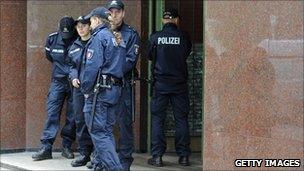Analysis: The German terror connection
- Published

The Taiba mosque in Hamburg, closed this year, was frequented by some of the 9/11 attackers
The deaths of four Germans in a US drone strike on Taliban militants in north-west Pakistan coincide with intelligence warnings of a possible al-Qaeda plot to attack European capitals, including Berlin.
By piecing together all the information, a picture emerges of a well-established German terror connection.
The German authorities have said that about a dozen militants disappeared from Hamburg in 2009. One of them appears to be have been arrested by the Americans earlier this year and to have supplied information about possible targets.
He is believed to be Ahmed Sidiqi, a German of Afghan descent and a frequenter of a mosque in Hamburg that was attended by some of the 9/11 attackers and closed in August.
He also moved in the same circles. For example, he knew Mounir al-Motassadek who was imprisoned for being a member of a terrorist group. At his trial, it emerged that al-Motassadek had handled money for some of the attackers.
Like al-Motassadek, Mr Sidiqi had worked at Hamburg airport.
The Hamburg Islamists who vanished in 2009 were all associated with the same mosque.
Among those killed in northern Pakistan in the drone attack were German citizens.
So a picture emerges of a cell in Hamburg involved in the attacks on the World Trade Center that is still active, probably with members among the victims in Waziristan from where the security agencies think they were preparing further attacks.
What is not known is whether the recent warnings of imminent attacks in Western Europe came from Ahmed Sidiqi in his cell at Bagram airbase in Afghanistan.
'High abstract threat'
One mystery is why the German government's assessment of the risk of attack is so different from that of the Americans.
The US authorities have been so firm that the danger is pressing in contrast to the German interior minister's view, expressed at a news conference on Monday, that there are "no indications of imminent attacks in Germany".
Was the German minister, Thomas de Maiziere, sceptical of the information the Americans had from their captive when he spoke of a "high abstract threat"?
Or was he speaking after the drone attack? Could he have been aware at the time that a German cell might have been broken?
We do not know. Nor do we quite know what was being planned.
But you get a flavour from the trial of David Headley, a US citizen of Pakistani background. Earlier this year he admitted plotting to attack a Danish newspaper. The plan was to enter the building and kill as many people as possible.
With the tightening of security at airports, hijacking aircraft has become very difficult so the focus of terror groups may have changed.
Bursting into a hotel or a railway station as happened in Mumbai is obviously harder to prevent than taking a bomb on to a plane.
Hence the warning from the US authorities about visiting crowded places with clear attack potential.
What happened to the other people who vanished from Hamburg a year ago is unknown. And if the Americans thought an attack was likely soon, could the people killed in Pakistan have been the perpetrators from that distance?
The drone may have killed people with extremely bad intentions, but the threat remains.
Whether it is "abstract" or more imminent is unclear.
- Published5 October 2010
- Published5 October 2010
- Published5 October 2010
- Published4 October 2010